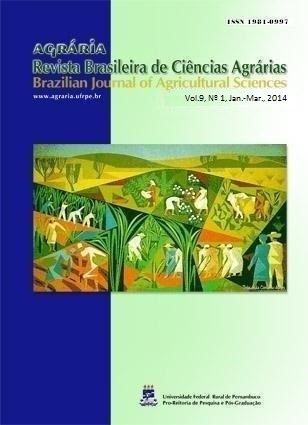Crescimento e absorção de nutrientes por mudas de pinus sob fontes de fertilizantes fosfatados
DOI:
https://doi.org/10.5039/agraria.v9i1a3193Palavras-chave:
fertilizante de liberação controlada, nutrição florestal, Pinus elliottii, qualidade de mudasResumo
Este trabalho objetivou avaliar o efeito das mudanças na disponibilidade de nutrientes do substrato, em função de doses e fontes de fósforo e fertilizante de liberação controlada em mudas de pinus (Pinus elliottii Engel). Mudas de pinus foram cultivadas em substrato composto por 50% de horizonte subsuperficial de um Nitossolo argiloso e 50% de areia pura, uniformemente misturado. Os tratamentos com fontes de fertilizante foram: fosfato natural, fosfato solúvel e um fertilizante de liberação controlada nas doses meia (0,18 kg P2O5 m-3), total (0,36 kg P2O5 m-3) e duas vezes (0,72 kg P2O5 m-3) a recomendada em um delineamento experimental inteiramente casualizado, com quatro repetições. Foram avaliados o desenvolvimento das mudas, parâmetros morfológicos, massa seca e acúmulo de nutrientes aos 330 dias após a germinação. Os resultados mostram que o fertilizante de liberação controlada promove melhor crescimento das mudas, maior diâmetro do caule e maior acúmulo de massa seca aos 330 dias após a germinação. Fosfatos naturais e solúveis não são eficazes na promoção do desenvolvimento de mudas de pinus em comparação com fertilizante de libertação controlada mas o fosfato solúvel ainda é muito melhor do que o fosfato natural.
Downloads
Downloads
Publicado
Como Citar
Edição
Seção
Licença

Este trabalho é licenciado sob uma licença Creative Commons Attribution-NonCommercial 3.0 Unported License.


